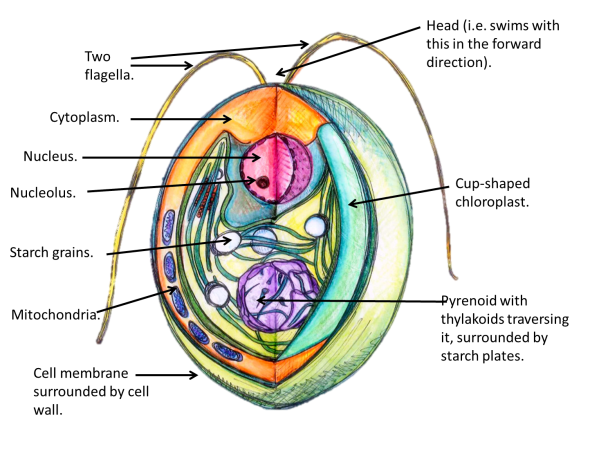Algae
Introduction
“Algae” can sometimes be a confusing term, as it has historically been applied to organisms from utterly different branches of the evolutionary tree, and moreover, even now that this confusion has been resolved, the true group of algae contains both single celled and seemingly multicellular organisms.
Lets clear all of this up first off:
- Algae are all eukaryotes. In the past, cyanobacteria, which are, as the name suggests, bacteria, were often called the “blue-green algae,” but this is no longer accepted, hence cyanobacteria are now not classified as algae. For details of the relationships between different algal groups, see Evolution below.
- Algae can be truly single-celled, like Chlamydomonas; single-celled but colonial, such as the genus Scenedesmus (the right-hand middle picture on this post); or multicellular (such as the seaweeds, although this is a coloquial term encompassing a polyphyletic group (that is, a group of organisms from different evolutionary lineages whose most recent common ancestor would not have been classified within the group) so should be treated with caution).
If we ignore the so-called brown algae, which are part of an evolutionarily far-removed group of organisms along with the diatoms, the kingdom of life with which we are concerned is the Archaeplastida (formerly Plantae). This includes the green algal lineage (which goes under a number of different names including viridiplantae, chlorobionta or chloroplastida) from which the green plants arose. The green algae/plants share a common ancestor most recently with the red algae (rhodophyta), and this ancestor converges further back with an algal group called the glaucophytes:

Thus, ignoring the unrelated brown algae, the algae form a paraphyletic group within the monophyletic group that is the Archaeplastida – in other words, the green algae, red algae and glaucophytes share a common ancestor that would have also been an alga, but not all of its descendants are algae (green plants).
Green Algae – Structure
Within all the algal groups we have met there are single-celled, colonial and truly multicellular species. Focussing now on the green algae, as this is the group with which our research is concerned, examples of each include, respectively, Chlamydomonas, Volvox, and the Charophyceae, multicellular plant-like algae from within which the true plant lineage is thought to have sprung. The green algae all, by definition (and hence by descent) have primary chloroplasts (that is, chloroplasts of the type you will be familiar with in plants, that have descended from a likely cyanobacteria-like ancestor that was engulfed and retained in a single endosymbiotic event). Other cellular features of green algae are highly variable between species – for example some are motile and some are not.
The model green alga with which we are principally concerned in our research is the single-celled Chlamydomonas reinhardtii. In addition to the usual eukaryotic cell components, such as nucleus and mitochondria, each cell contains just the one chloroplast, within which is located a single pyrenoid (as in other green algae). Each Chlamydomonas cell also has two flagellae for motility, an eyespot associated with their chloroplast which allows for detection of light, and contractile vacuoles to maintain their osmotic balance and prevent lysis of the plasma membrane. This is also aided by a rigid cell wall (like plant cells) – for experimental purposes it is often desirable to produce wall-less cells which more easily take up plasmids containing genetically engineered constructs (see Experimental Techniques). This can be done by harvesting a substance called autolysin, which the cells produce during mating to break down the cell wall and enable fusion of the mating types, and adding this to our walled strains to remove the wall.
Chlamydomonas can be grown up in liquid media called TAP (tris-acetate-phosphate) or minimal media (lacking acetate) to force them to rely on photosynthesis. Chlamydomonas can also be grown on agar plates (again with either TAP or minimal media), which is useful experimentally as it allows for antibiotic mediated selection of transformants (i.e. when engineering cells to contain a gene sequence of interest, the construct also includes a selectable marker gene which confers resistance to a particular antibiotic. Only successfully transformed cells will have this antibiotic-resistance, hence only transformed cells will be able to grow on a plate containing the antibiotic).
Chlamydomonas is clearly of great interest and importance to the CAPP research project, as well as being a pretty interesting organism in its own right. It is useful as a model green alga, and green algae in turn are potentially invaluable to us as genetic resources for many areas of plant-based research.
